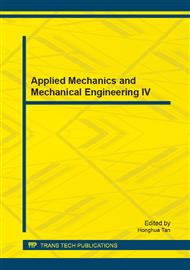[1]
D.J. Inman, C.R. Farrar, V. Lopes and V. Steffen: Damage Prognosis: For Aerospace, Civil and Mechanical Systems (John Wiley & Sons, England 2005).
DOI: 10.1002/0470869097
Google Scholar
[2]
C.R. Farrar and N.A.J. Lieven: Damage prognosis: the future of structural health monitoring. Phil. Trans. R. Soc. A. 365(2007), pp.623-632.
DOI: 10.1098/rsta.2006.1927
Google Scholar
[3]
Y.A. Shreider: Method of Statistical Testing-Monte Carlo Method (Elsevier Publishing Company, Amsterdam 1964).
DOI: 10.1002/bimj.19670090136
Google Scholar
[4]
Y. Liu and S. Mahadevan: Probabilistic fatigue life prediction using an equivalent initial flaw size distribution. International Journal of Fatigue. 31(2009), pp.476-487.
DOI: 10.1016/j.ijfatigue.2008.06.005
Google Scholar
[5]
R. Moor: Interval Arithmetic (Prentice-Hall, Englewood Cliffs, NJ 1996).
Google Scholar
[6]
K. Worden and G. Manson: Prognosis under uncertainty-An idealized computational case study. Shock and Vibration. 15(2008), pp.231-243.
DOI: 10.1155/2008/958343
Google Scholar
[7]
C. Surace and K. Worden: Extended Analysis of a Damage Prognosis Approach Based on Interval Arithmetic. Strain. 47(2011), pp.544-554.
DOI: 10.1111/j.1475-1305.2011.00815.x
Google Scholar
[8]
D. Xiu and J.S. Hesthaven: High-order Collocation Method for Differential Equations with Random Inputs. SIAM. 27(2005), pp.1118-1139.
DOI: 10.1137/040615201
Google Scholar
[9]
F. Zhao, Z. Tian and Y. Zeng: A stochastic collocation approach for efficient integrated gear health prognosis. Mechanical Systems and Signal Processing. 39(2013), pp.372-387.
DOI: 10.1016/j.ymssp.2013.03.004
Google Scholar
[10]
H.D. Bui: Fracture Mechanics-Inverse Problems and Solutions (Springer, Netherlands 2006).
Google Scholar
[11]
J. Jakeman, M. Eldred and D. Xiu: Numerical Approach for Quantification of Epistemic Uncertainty. Journal of Computational Physics. 229(2010), pp.4648-4663.
DOI: 10.1016/j.jcp.2010.03.003
Google Scholar
[12]
V. Barthelmann, E. Novak and K. Ritter: High dimensional polynomial interpolation on sparse grids. Advances in Computational Mathematics. 12(2000), pp.273-288.
DOI: 10.1023/a:1018977404843
Google Scholar
[13]
S.A. Smolyak: Quadrature and interpolation formulas for tensor products of certain classes of functions. Soviet Math. Dokl. 4(1963), pp.240-243.
Google Scholar
[14]
M.A. Langøy and S.R. Stock: Fatigue-crack Growth in Ti-6Al-4V-0. 1 Ru in Air and Seawater: Part1. Design of Experiments, Assessment, and Crack-Growth-Rate Curves. Metallurgical and Materials Transactions. 32A (2001), pp.2297-2314.
DOI: 10.1007/s11661-001-0204-9
Google Scholar
[15]
W. Shen, A.B.O. Soboyejo and W.O. Sobyejo: Probabilistic modeling of fatigue crack growth in Ti-6Al-4V. International Journal of Fatigue. 23(2001), pp.917-925.
DOI: 10.1016/s0142-1123(01)00045-7
Google Scholar
[16]
D. Brock: Elementary Engineering Fracture Mechanics (Kluwer Academic Publishers, Dordrecht 1982).
Google Scholar


